Case Report: 10CA006
Gardener dies when he falls out of a tree while trimming the branches
Download a PDF to print this report:
Gardener dies when he falls out of a tree while trimming the branches (10CA006, PDF)
Summary
A self-employed gardener died when he fell 20 feet out of a pine tree while trimming the branches. The victim was hired by a homeowner to do routine yard maintenance and asked him to trim the pine tree in the front yard. The victim asked another self-employed gardener to assist him with this job. The victim climbed the pine tree without wearing any fall protection. The co-worker went to the back of the house to perform other duties and when he returned to the front of the house, he found the victim at the base of the tree. No one witnessed the incident. The CA/FACE investigator determined that in order to prevent future incidents, gardeners who trim trees should ensure that:
- They have received training and certification on how to safely trim trees by qualified instructors.
- Fall protection is worn when climbing trees.
In addition, homeowners should:
- Hire only tree trimmers who are certified by organizations such as the ISA (International Society of Arboriculture) or the TCIA (Tree Care Industry Association).
Introduction
On Tuesday, May 11, 2010, at approximately 10:30 a.m., a 39-year-old Hispanic gardener died when he fell approximately 20 feet out of a pine tree he was trimming. The CA/FACE investigator received notification of this incident from the Los Angeles Coroner on May 27, 2010. On September 30, 2010, the CA/FACE investigator interviewed the other self-employed gardener working with the victim at the time of the incident. The homeowner and neighbors were also interviewed and pictures were taken of the tree involved in the incident. A copy of the police and coroner reports were also obtained.
Employer
The victim was a self-employed gardener who had worked in this business for the past 10 years.
Written Safety Programs and Training
The victim did not have an Injury and Illness Prevention Program (IIPP). According to the other self-employed gardener working with the victim, they never had any formal training in gardening, landscaping or tree trimming. He stated that they learned the gardening trade from working with other gardeners and each other.
Worker Information
The victim was born in Mexico and had been in the United States for the past 20 years. He had a 9th grade education and spoke both English and Spanish.
Incident Scene
The location of the incident was a single family dwelling in a populated residential area of Los Angeles County. The tree involved in the incident was a pine tree in the front yard of the residence that was approximately 35 feet in height. The trunk of the tree measured approximately 20 inches in diameter. The homeowner had hired the victim to perform routine gardening at their home such as mowing and edging the front and back lawns, weeding the flower beds, and sweeping up fallen leaves and pine needles. A week prior to the incident, the homeowner had asked the victim to trim the pine tree in the front yard.
Investigation
On the day of the incident, the victim solicited the help of a fellow self-employed gardener who he had worked with on numerous odd jobs in the past. When they arrived at the job location, the victim climbed the pine tree and began trimming branches without the benefit of any fall protection. The other gardener went to the back yard of the house to do other gardening chores. After a few minutes, the other gardener came back to the front of the house and found the victim lying at the base of the pine tree among some cut branches. No one witnessed the victim fall and the homeowner was not at home when the incident occurred. The other gardener immediately called 911 from his cellular phone.
The paramedics and fire department arrived at the incident scene within six minutes of the call. The victim was transported to a local hospital by ambulance where resuscitative and other measures were applied, however the victim died from his injuries.
Cause of Death
The cause of death according to the death certificate was blunt force injuries.
Recommendations/Discussion
Gardeners who trim trees should ensure that:
Recommendation #1: They have received training and certification on how to safely asses hazards and climb trees by qualified instructors.
Discussion: In this incident, the victim climbed up a pine tree and began trimming the branches before properly assessing the tree for any known hazards and taking the appropriate safety measures. According to the other gardener working with the victim, neither of them had received any training or certification in tree trimming. The ISA and the TCIA are organizations that certify tree trimmers in all aspects of job safety, including how to perform a safety hazard assessment of a pine tree including the inspection of:
- The surrounding area.
- The species and shape of the tree.
- The lean of the tree.
- Loose limbs, chunks, or other overhead material.
- Wind force and direction.
- Dead, decayed, or weak spots throughout the tree.
- Size and terrain characteristics and limitations of the work area.
- Evidence of bees or wildlife habitation in the trees.
- Means to protect the public and property.
- Safety equipment needed to do the job safely.
- The best methods for trimming pine trees.
All certified tree workers must pass a knowledge and skills exam conducted by trained evaluators. If the victim had received training and certification he may have had the knowledge to recognize the hazards posed by the pine tree branches and performed the job in a safe manner.
Recommendation #2: Fall protection is worn when climbing trees.
Discussion: In this incident, the victim climbed into the pine tree to trim the branches without the benefit of any fall protection. Based on the cut branches in the tree, it was estimated that the victim fell approximately 20 feet. Fall protection for tree trimmers may consist of a body harness, tree workers’ saddles, rope lanyards, and climbing ropes long enough to fit around the tree being trimmed. Bucket trucks and aerial lifts have made work in tall trees easier and safer. Fall protection would have still been required if the victim had chosen to use a bucket truck or aerial lift to access the tree. Had the victim been wearing the required fall protection, his death might have been prevented.
In addition, homeowners should:
Recommendation #3: Hire only tree trimmers who are certified by organizations such as the ISA (International Society of Arboriculture) or the TCIA (Tree Care Industry Association).
Discussion: In this incident, the homeowner hired the local gardener in the area to do what most consider non-skilled labor. The victim was not aware of all the hazards associated with the task of trimming a tree. He climbed the tree to approximately the 20 foot level and did not use any type of fall protection. While trimming the tree branches with a hand-held saw, he fell out of the tree to the ground below. When hiring a worker or company that has been trained and accredited in tree trimming, homeowners can be assured that the work will be performed according to recommended safe work practices.
Exhibits
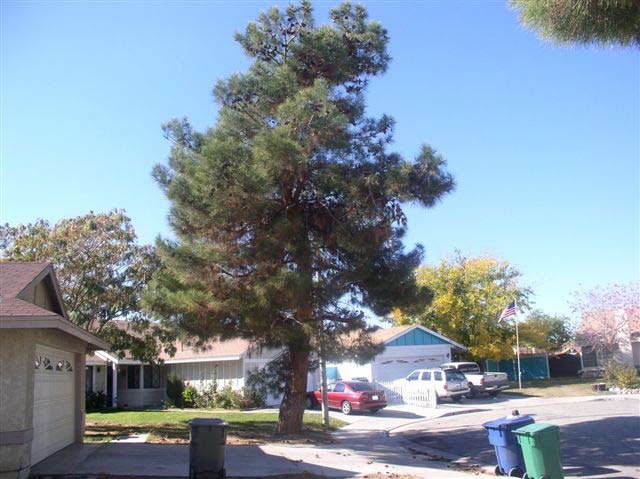
Exhibit 1. The pine tree involved in the incident looking north.
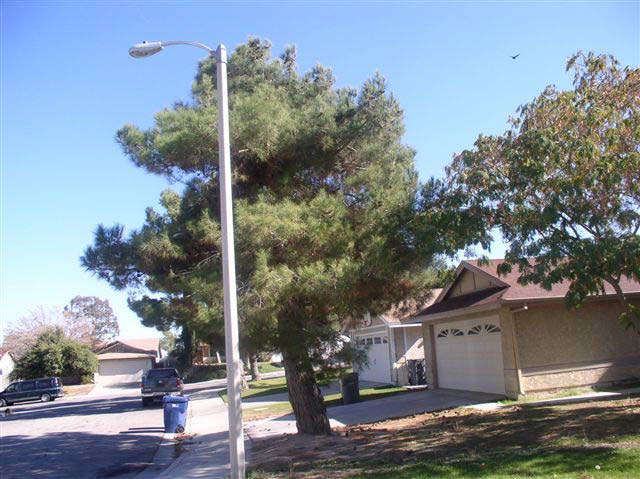
Exhibit 2. The pine tree looking south.
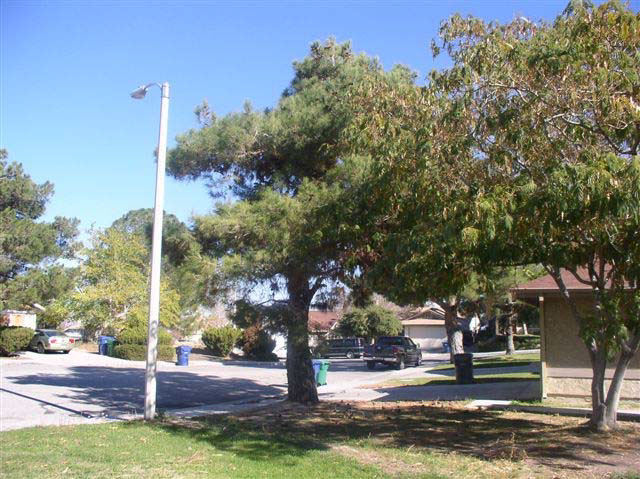
Exhibit 3. The pine tree looking east.
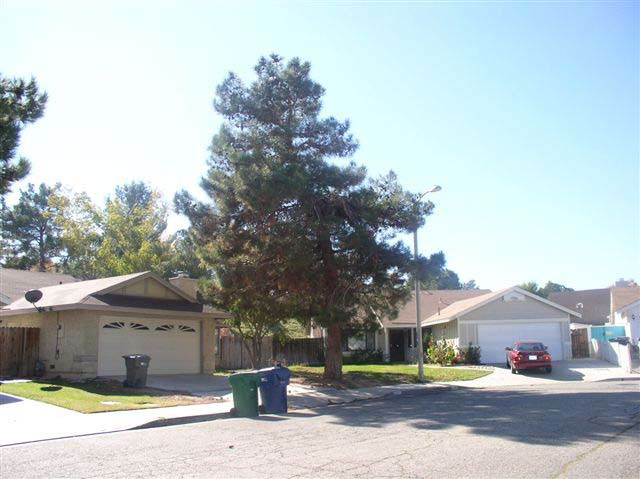
Exhibit 4. The pine tree looking west.
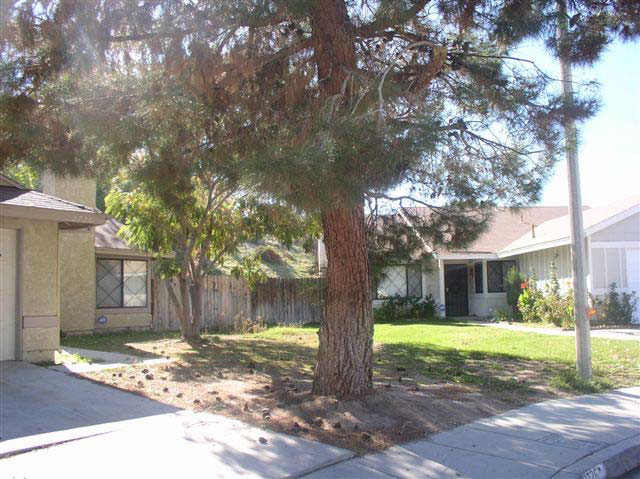
Exhibit 5. The front yard where the pine tree was located.
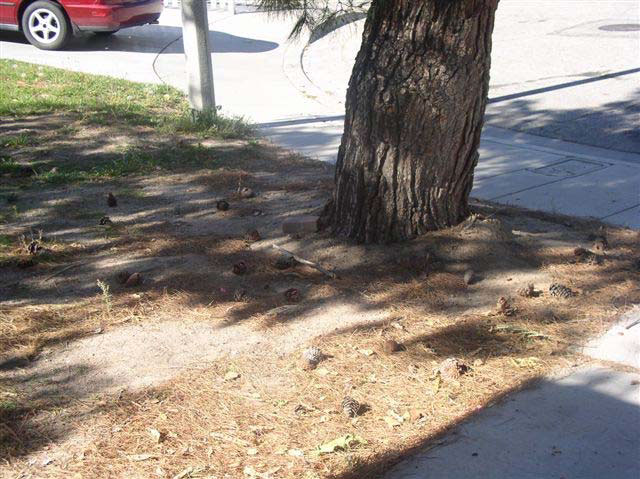
Exhibit 6. The ground at the base of the pine tree.
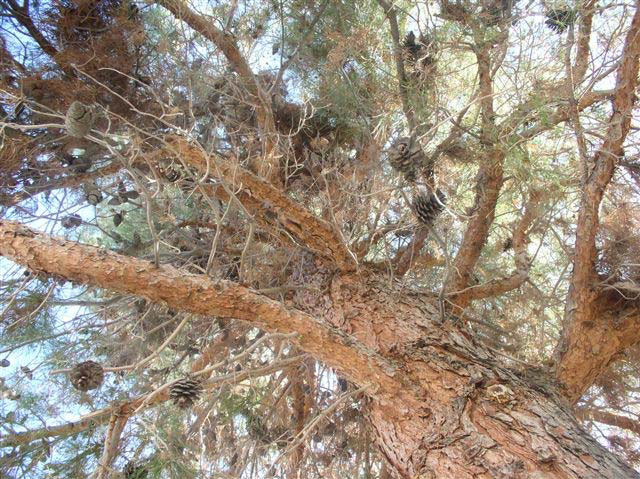
Exhibit 7. The inside portion of the pine tree.
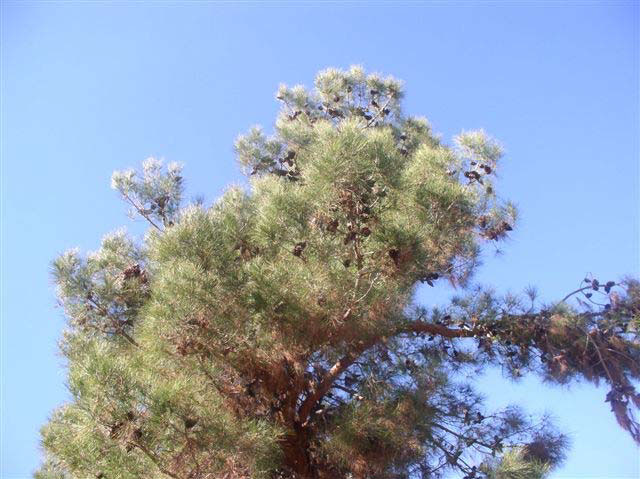
Exhibit 8. The branches in the pine tree.
References
Division of Occupational Safety and Health - Title 8 regulations - Subchapter 7 - General Industry Safety Orders Group 3. Tree Work, Maintenance or Removal §3421. General. §3427. Safe Work Procedures. §3428. Operating Rules.
Article 24. Fall Protection. §1669. General. §1670. Personal Fall Arrest Systems, Personal Fall Restraint Systems and Positioning Devices. §1671. Safety Nets. §1671.1. Fall Protection Plan.
Preventing Falls and Electrocutions During Tree Trimming - NIOSH ALERT: August 1992 DHHS (NIOSH) Publication No. 92-106
How to Hire an Arborist - Sacramento Tree Foundation website
Training Workshops – Tree Care Industry Association (TCIA) website
Fact Sheet: Fatal Injuries among Landscape Services Workers (PDF) - NIOSH Publication No. 2008-144
"Reducing the Hazard of Climbing Falls" - Tree Worker, June 2006, No. 286.
Authors
Hank Cierpich, FACE Investigator
Robert Harrison, MD, MPH, FACE Project Officer
Laura Styles, MPH, Research Scientist
February 3, 2011